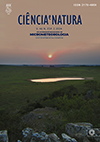Comparison of mixing Length parametrizations under different stability conditions in the nocturnal atmospheric boundary layer
DOI:
https://doi.org/10.5902/2179460X87948Keywords:
Turbulence, Stable Boundary Layer, Mixture LenghtAbstract
Mixing length was introduced in the early 20th century to determine turbulent viscosity. Since then, various formulations have emerged, reflecting the complexity of parameterizing turbulent fluxes, especially under strongly stable conditions. This study proposes a new mixing length formulation based on the dissipation of turbulent kinetic energy, avoiding autocorrelation issues. Results show the new formulation behaves consistently, decreasing with stability in weakly stable conditions and increasing in strongly stable conditions. Comparisons with other formulations indicate that this approach offers a more robust description of turbulence in the stable boundary layer (SBL).
Downloads
References
Acevedo, O. C., Costa, F. D., Maroneze, R., Carvalho, A. D., Puhales, F. S., Oliveira, P. E. (2021). External controls on the transition between stable boundary-layer turbulence regimes. Quarterly Journal of the Royal Meteorological Society, 147(737), 2335–2351. DOI: https://doi.org/10.1002/qj.4027
Arya, P. S. (2001). Introduction to micrometeorology. Elsevier.
Blackadar, A. K. (1962). The vertical distribution of wind and turbulent exchange in a neutral atmosphere. Journal of Geophysical Research, 67(8), 3095–3102. DOI: https://doi.org/10.1029/JZ067i008p03095
Delage, Y. (1974). A numerical study of the nocturnal atmospheric boundary layer. Quarterly Journal of the Royal Meteorological Society, 100(425), 351–364. DOI: https://doi.org/10.1256/smsqj.42506
Kim, J., Mahrt, L. (1992). Simple formulation of turbulent mixing in the stable free atmosphere and nocturnal boundary layer. Tellus A, 44(5), 381–394. DOI: https://doi.org/10.1034/j.1600-0870.1992.t01-4-00003.x
Klipp, C. L., Mahrt, L. (2004). Flux–gradient relationship, self-correlation and intermittency in the stable boundary layer. Quarterly Journal of the Royal Meteorological Society: A journal of the atmospheric sciences, applied meteorology and physical oceanography, 130(601), 2087–2103. DOI: https://doi.org/10.1256/qj.03.161
Mahrt, L. (1998). Stratified atmospheric boundary layers and breakdown of models. Theoretical and computational fluid dynamics, 11(3-4), 263–279. DOI: https://doi.org/10.1007/s001620050093
Mahrt, L., Vickers, D. (2003). Formulation of turbulent fluxes in the stable boundary layer. Journal of the atmospheric sciences, 60(20), 2538–2548. DOI: https://doi.org/10.1175/1520-0469(2003)060<2538:FOTFIT>2.0.CO;2
Mahrt, L., Vickers, D. (2005). Boundary-layer adjustment over small-scale changes of surface heat flux. Boundary-layer meteorology, 116, 313–330. DOI: https://doi.org/10.1007/s10546-004-1669-z
Mahrt, L., Vickers, D. (2006). Extremely weak mixing in stable conditions. Boundary-layer meteorology, 119, 19–39. DOI: https://doi.org/10.1007/s10546-005-9017-5
Nieuwstadt, F. T. (1984). The turbulent structure of the stable, nocturnal boundary layer. Journal of Atmospheric Sciences, 41(14), 2202–2216. DOI: https://doi.org/10.1175/1520-0469(1984)041<2202:TTSOTS>2.0.CO;2
Rodrigo, J. S., Anderson, P. S. (2013). Investigation of the stable atmospheric boundary layer at halley antarctica. Boundary-layer meteorology, 148(3), 517–539. DOI: https://doi.org/10.1007/s10546-013-9831-0
Sorbjan, Z., Grachev, A. A. (2010). An evaluation of the flux–gradient relationship in the stable boundary layer. Boundary-layer meteorology, 135, 385–405. DOI: https://doi.org/10.1007/s10546-010-9482-3
Sun, J. (2011). Vertical variations of mixing lengths under neutral and stable conditions during cases-99. Journal of applied meteorology and climatology, 50(10), 2030–2041. DOI: https://doi.org/10.1175/JAMC-D-10-05006.1
Sun, J., Mahrt, L., Banta, R. M., Pichugina, Y. L. (2012). Turbulence regimes and turbulence intermittency in the stable boundary layer during cases-99. Journal of the Atmospheric Sciences, 69(1), 338–351. DOI: https://doi.org/10.1175/JAS-D-11-082.1
Sun, J., Takle, E. S., Acevedo, O. C. (2020). Understanding physical processes represented by the monin–obukhov bulk formula for momentum transfer. Boundary-Layer Meteorology, 177(1), 69–95. DOI: https://doi.org/10.1007/s10546-020-00546-5
Downloads
Published
How to Cite
Issue
Section
License
Copyright (c) 2024 Ciência e Natura

This work is licensed under a Creative Commons Attribution-NonCommercial-ShareAlike 4.0 International License.
To access the DECLARATION AND TRANSFER OF COPYRIGHT AUTHOR’S DECLARATION AND COPYRIGHT LICENSE click here.
Ethical Guidelines for Journal Publication
The Ciência e Natura journal is committed to ensuring ethics in publication and quality of articles.
Conformance to standards of ethical behavior is therefore expected of all parties involved: Authors, Editors, Reviewers, and the Publisher.
In particular,
Authors: Authors should present an objective discussion of the significance of research work as well as sufficient detail and references to permit others to replicate the experiments. Fraudulent or knowingly inaccurate statements constitute unethical behavior and are unacceptable. Review Articles should also be objective, comprehensive, and accurate accounts of the state of the art. The Authors should ensure that their work is entirely original works, and if the work and/or words of others have been used, this has been appropriately acknowledged. Plagiarism in all its forms constitutes unethical publishing behavior and is unacceptable. Submitting the same manuscript to more than one journal concurrently constitutes unethical publishing behavior and is unacceptable. Authors should not submit articles describing essentially the same research to more than one journal. The corresponding Author should ensure that there is a full consensus of all Co-authors in approving the final version of the paper and its submission for publication.
Editors: Editors should evaluate manuscripts exclusively on the basis of their academic merit. An Editor must not use unpublished information in the editor's own research without the express written consent of the Author. Editors should take reasonable responsive measures when ethical complaints have been presented concerning a submitted manuscript or published paper.
Reviewers: Any manuscripts received for review must be treated as confidential documents. Privileged information or ideas obtained through peer review must be kept confidential and not used for personal advantage. Reviewers should be conducted objectively, and observations should be formulated clearly with supporting arguments, so that Authors can use them for improving the paper. Any selected Reviewer who feels unqualified to review the research reported in a manuscript or knows that its prompt review will be impossible should notify the Editor and excuse himself from the review process. Reviewers should not consider manuscripts in which they have conflicts of interest resulting from competitive, collaborative, or other relationships or connections with any of the authors, companies, or institutions connected to the papers.







